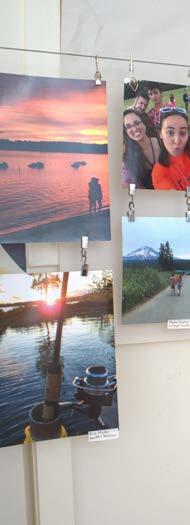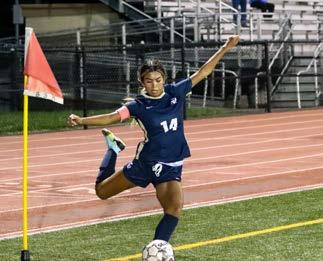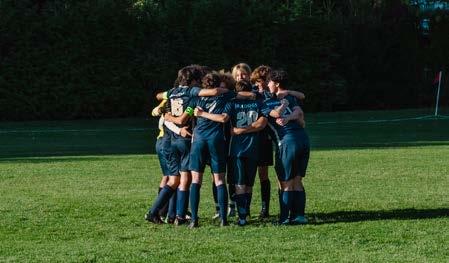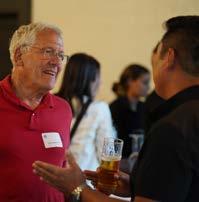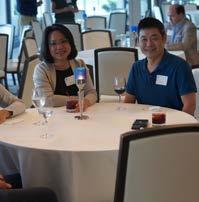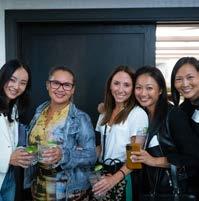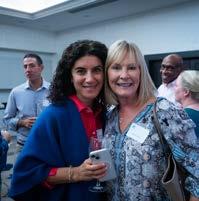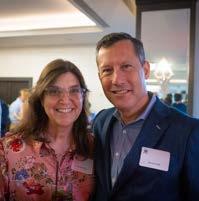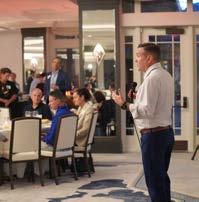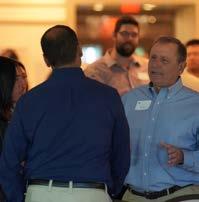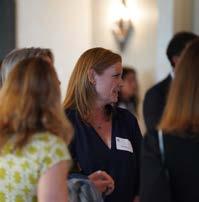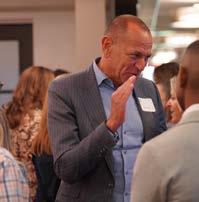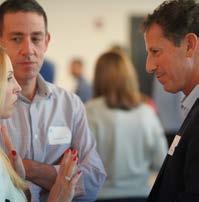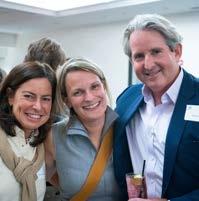Investiture Ceremony
Honors Pat Boig, Welcomes Jeremy Gregersen
Members of the D-E Board of Trustees, Trustees Emeriti, the Head of School Search Committee, and the D-E Leadership Team all gathered together in Hajjar STEM Center for an early December Investiture event recognizing then-Head of School-Elect Jeremy Gregersen.







During the Investiture, Robert (“Rob”) E. Miller, President of the D-E Board of Trustees, honored and thanked then-Interim Head of School Patricia (“Pat”) Gedney Boig for her “above and beyond” service to the School and presented her with a “small token” of appreciation.
 Jeremy Gregersen was presented with a symbolic, custom-inscribed “key” to Dwight-Englewood School by Rob Miller.
Jeremy Gregersen was presented with a symbolic, custom-inscribed “key” to Dwight-Englewood School by Rob Miller.
2
The Investiture Ceremony for then-Head of School-Elect Jeremy Gregersen took place in early December in the Hajjar STEM Center. In attendance during this small, private, but very meaningful ceremony were members of the D-E Board of Trustees, Trustees Emeriti, the Head of School Search Committee, and the D-E Leadership Team. The gathering was at times solemn but also highly inspiring, in keeping with the tradition of an investiture event.


The ceremony officially began when Robert (“Rob”) E. Miller, President of the D-E Board of Trustees, provided remarks which first included words of sincere thanks to then-Interim Head of School Patricia (“Pat”) Gedney Boig. Rob also praised the Head of School Search committee for their commitment to the extremely complicated and critically important process of finding finalists and then ultimately securing Jeremy Gregersen as our next Head of School. Pat graciously acknowledged the work and dedication of the Leadership Team, which at her request surrounded her behind the podium. Rob then presented a large, inscribed key to the School to Jeremy.

Jeremy followed with inspiring remarks of his own, thanking both Rob Miiller, the Trustees and Search Committee, as well as Pat directly; indicating his excitement for having the privilege of joining the D-E community in the Head of School role; and quoting from poetry by Robert Frost. Jeremy’s remarks at times drew some chuckles as well as applause, particularly when indicating the degree to which his family has been warmly welcomed and embraced by all they’ve encountered thus far in the D-E community. Together with his wife Liz, Jeremy now has moved to Collins House with his son Jack ‘29, who has joined the Middle School, and 3-year-old son Billy.
Families, faculty/staff, alumni and friends of the D-E community are all encouraged to “Save the Date” for the official Installation of Jeremy Gregersen on Sunday, May 7 at 2 PM on Leggett Field. Installation invitation and more detailed information will be provided in early 2023. Questions may be directed in the interim to the Executive Assistant to the Head of School, Annmarie Michalek, via Email at: michaa@d-e.org.






3
While Math is sometimes pigeonholed as a daunting subject, D-E’s Mathematics Department faculty are dedicated to serving students’ needs and creating curriculum that allows them to both thrive within and develop passion for math. See how each division builds upon one another and how mathematics learning looks different in stages of development.

4
What is your primary focus in your role?
Our faculty, regardless of if they teach within the Lower, Middle and/or Upper Schools, are committed to student-based learning, problem-based learning, and student-focused interactions in the classroom. So, my primary focus is to put some structure around that and make sure that we have a continuum from the lower grades up through the high school grade levels, in terms of our educational approach. We’re very intentional about the way that we go from one stage of the curriculum to the next. We aim to give our students not only a smooth experience in general but also build a love of learning through math experiences that are pedagogically- and ageappropriate.
For example, in the Upper School, we’re big into problem-based learning. Our integrated program for the 9th and 10th grades is pretty much all problem-based learning. We wanted to move some of that down into the Middle School because we have middle schoolers who have fairly advanced mathematical thoughts. We thought that they would be able to handle the problem-based approach. However, we have learned that what’s pedagogically age-appropriate for Middle School students is not quite the same as that of Upper School students. So we have introduced problembased learning into the eighth grade advanced curriculum, but not into the CP curriculum. We feel that while they’re still building their foundational skills, it’s better to have more of a focus on the foundations with the problembased learning sprinkled in. In seventh grade, we have a lot of foundational work, as well as some problem solving; it’s a mixture in sixth grade as well.
But once students get to the early grades of Upper School (e.g., ninth and tenth grades), all of their math learning revolves around problems and problem sets. The teacher acts as the coach, while students try to solve all the problems at least initially by themselves. They present their work while their classmates comment on whether they did the problems in the same way or a different way. They come to a collective conclusion as to what the answer would be and figure out what are several viable approaches for getting to the answer.
If students don’t know something, whether they lack some foundational skill or don’t know what they need to know in order to solve the problem, then the teacher may jump in. If they’re floundering amongst themselves as to how to approach the problem, the teacher may suggest something to put them back on track, or they may redo a problem in class in small groups in order to make sure that everyone is understanding it. Then there’s some responsibility on the students to reflect in the evening on what they tried.
We want our students to ask questions like: “What did you realize as you were sitting in class from the discussion?
What does this process make you think now?”
It’s important that students take notes in their notebooks, so that they’re understanding the problems and asking good questions of their teacher -- maybe they realize they need to revisit a problem and can ask for that support the next day. In our problem-based approach, there’s definitely more direction from the students themselves, which is the main developmental reason that we can’t just do that at every age group. When students enter the Upper School, they’re at the right age where they can direct their own learning.
Can you discuss more about how you integrate the curriculum across all three divisions?

In the Lower School, we do a lot of Singapore Math, which mean lots of diagrams and manipulatives to visualize what a ratio or proportion looks like in terms of blocks or lines: something that they draw on a piece of graph paper. This way they are not solely learning the steps to divide fractions as in you flip the second one and multiply them. Instead, they’re learning the process: “if I have this something that’s nine units of ribbon that’s nine yards and I want to give everybody a third of a yard for an art project, how many total pieces do I get?” Rather than just saying: “you take nine and you divide it by a third which means you’re going to multiply it by three over one and get 27,” they’re actually seeing, “Oh, I have nine units. So each one of those nine units is one, but I need a third. So I can get three for each of the one.”
That kind of thinking leads right into what we do in Middle School where they learn a lot more abstract notation like learning what “X” is and then solving for it. Then in the later years in Middle School and the beginning years in Upper School, they learn how to take a problem and regularly ask: “what are all the tools I can use?” You see students even when they get to seventh, eighth, ninth grades, still referring back to those initial diagrams that they drew back in fifth or fourth grades. But you can see that that’s been a part of their mathematical thinking. It becomes part of their toolbox.
5
What we are talking about is very visual, spatial, and geometric. And, you know, we don’t teach a separate Algebra I, then Geometry and then Algebra II and all of that… because it’s really all the same… it’s Math, right? Geometry isn’t fundamentally a different math. Nor is Algebra. It’s just a different way of looking at things.
And so, we try to start that idea in the Lower School where students look at things from an arithmetic standpoint, as well as from a visual spatial standpoint. And then that turns into looking at something from an algebraic geometry perspective when they start learning those words. And they start understanding abstraction a little bit better.
Data and data collection is another part of our curriculum. In our most advanced sixth grade math class, we asked our students to figure out what the steepest staircase on campus is, to understand slope. They’re going to have to go out and collect data on a staircase. They are going to have to ask: “Well, what do I need to know in order to figure out how steep this is?” This means that first they have to figure out what kind of data are they going to collect. Then, they have to figure out a way to collect that data and a unit to measure it in. Finally they have to figure out once they’ve collected their data, what does it all mean? By modeling the situation in a real way, we can move into ideas of linearity and what slope is.
Our official name for ninth and tenth grade math is Integrated Mathematics and Modeling (IMM). It’s integrated because it’s not just one branch of mathematics. And it’s referred to math and modeling because we do real life data. We may have a theoretical situation where there isn’t actual data that’s been measured, but our students are still going to use a function or a graph or something to model the situation of what’s going on. So we may give them a projectile motion problem where everything’s perfect. We don’t worry about air resistance, friction, etc. But we’re still going to investigate how math applies in real life.
What are the differences from a typical math curriculum in comparison to D-E’s approach?
A typical math curriculum is very much focused on what topics are being covered. Students learn from one topic then jump to another topic and then another topic. Topics usually get increasingly more difficult, but the student generally knows that if they have five problems to do, that all five of those problems are going to relate to a particular subject. Consider the Pythagorean theorem for example. If a student knows the problems given will be about the Pythagorean theorem, they won’t look at a new problem with fresh eyes. The issue is that this is not quite as sophisticated a way of learning. It’s a little bit easier on students. So sometimes students resist a bit because they want to be told what tool to use. And as we all know, that’s not how the world works when you come across a problem in your life. Nobody says to you, “oh, you’re going to apply this [theorum] to solve that problem.”

Here’s to this year’s Math Days! Math Days is an all division event where all D-E students receive the same problem to illustrate and solve. Upper School students came down to the Lower School to support problem-solving, and it was a wonderful moment for learning for all.

See how the students visualized their thinking and brought math to life.
THE PROBLEM:
There are kindergarteners and cows playing on the D-E Lower School playground. A teacher counts a total of 18 feet.
How many kindergarteners and how many cows could there be?
CS
A N M E FORADDITIONAL CONTENTONDETOD A Y O GR
6
The first step in our process is always to understand the problem and figure out an approach. We think there’s a huge benefit to kids in their lifelong math learning, as well as life learning in general, to having to do that problem solving activity at the beginning, where they figure out how to try or what to try or if they don’t know what to try, try something. See how it goes. That’s the big difference at D-E. We want our students to ask: “what are the math tools in my toolbox that I have to solve this problem?”
With that said, we have the concepts or threads, to which problems in our curriculum relate. They may relate to more than one topic; there might be an exponential aspect to a problem as well as geometric aspect of a problem, for example. So we do help our students figure out what threads are woven through the curriculum and relate to the problem, so that they can be a bit more enlightened to what tools tend to be employed in which situations. Then they can also say, “Well, you know, I realized that I was using the Pythagorean theorem in this one instance. And then also I saw it in this other instance. And then I saw this other thing with a function that also reminded me of that...”. This way our students get a much deeper and richer experience because they can see threads across problems.
Sometimes when students have come from a different background, and then they come here to D-E, it takes a bit of time to adjust and buy into the idea that this is a good way to learn math.
[At its core] we want all students to feel challenged, enriched and excited in positive ways by the problem-solving approach I’ve described, as opposed to feeling worried, overwhelmed or frustrated. [Our faculty all remain attentive to all of this throughout the process of getting our students more accustomed and comfortable with learning Mathematics through problem solving.]

Within
the faculty,
how do you (similarly)
collaborate with one another and imagine strategies for students’ engagement?
If we just keep talking about the kind of the problem-based IMM curriculum, for example, our teachers obviously have all done the problems before themselves, and they can talk to one another about what occurred for them. There’s an aspect of being able to think about what it’s going to be like for the student before interacting with the students. So that’s one piece where faculty can benefit from bouncing ideas and concepts off each another.
If we have a new faculty member teaching the curriculum then that person would have that relationship with one of the other teachers who’s been doing it longer. But really, I would say the majority of the conversation and the work among faculty members is more about how to coach for a particular set of problems or threads: what are the questions that we see from students? What are the points of confusion?
[Our work is about] helping the kids to discover the many ways to approach a problem rather than what is the right way, or the best way, or the most efficient way. In some cases, there might be a preferable solution, and in other cases, it’s about appreciating how people can see things differently.
We try to understand what the math looks from the other person’s perspective, then trying to integrate whatever that new topic, idea, process, problem, whatever it is, into what everybody else already knows. So we’re trying to create more experiences that will then make everybody a better problem solver. Even amongst faculty, we’re all kind of all learning all the time. It’s that whole life-long learning principle that we value here at D-E. And I think in the math and computer science department, we do live by that principle.
7
Math is often stereotyped as a disliked subject. With those preconceived notions, how do you build confidence?
[I believe that we build the most confidence in our students through small group work.] In small groups, students realize that they have a contribution that maybe somebody else didn’t think of. I think that just naturally builds confidence. And when you can explain something to somebody else, first of all, you really understand it. And secondly, you can feel good about that! I think a big part of group work and collaboration is simply supporting each other whether students are presenting a problem to the rest of the class or in discussions. We also have periods like Math Lab, Middle School TAG, and office hours to support students in their learning.
What are the opportunities for interdisciplinary learning across departments?

We have two parts of our department: we have the math, and we have the computer science. There is a lot of integration there. Sometimes our best computer science students tend to also be our best math students, but that’s not always the case. A student may have developed a great love for computer programming and all things electronic and because they love gaming, and they want to write games, or whatever, but they haven’t necessarily been particularly interested in learning algebra. And so I think the integration of those two things really provides motivation for those students that might not otherwise be interested in learning math for its owns sake.
We see a lot of integration with engineering classes or robotics, for example. I have previously coached robotics and math, computer science, and physics are all being integrated and utilized. [The heart of robotics is that it’s a problem-based activity:] they’ve got a challenge every year, and they have to figure out, “how am I going to build a robot that accomplishes this challenge?” So that’s a very integrated aspect and the fact that we have the Hajjar STEM Center building makes that possible.
8
I think there’s a lot of room for a lot more integration, especially in the Middle School. For example, the Middle School has STEM initiatives, five robotics teams, and a physical computing class. The Library houses the Makerspace for students to have more hands-on learning and building, while the Lower School has a STEM specialist. Each division is invested in integrated and inter-disciplinary learning.
How would you like to expand D-E Mathematics Department’s curriculum in the future?
I want to continue expanding upon our elective program. Our department has more people doubling up or tripling up than any of the other departments. You know, we have hundreds of more enrollments than we have students in classes. So that means that the students are taking multiple math and computer science classes. As a result, I think we have a lot of room for introducing more electives for that. Some of our electives are really appealing to kids and some electives are not as appealing. The idea with the elective program is that you would have kids in the same classroom with lots of different experiences. But more typically our students are busy, and they fill up their schedule with all kinds of things. Often, we’ve ended up with an elective program where there tends to be many students that have had a certain math experience at a higher level and then some other electives where there are many students who have kind of been with each other having a different types of math experiences. I want to try to figure out what kind of electives can we offer that will move us back toward that integration. There are also topics like the concept of infinity or fourth and fifth dimensional space where we want to ask what that even means. [I feel that we need to] continually be infusing our program with additional classes.
I hope that our students all feel that they’ve taken ownership of their learning and math learning in particular. I hope that they have internalized and synthesized the math that they’ve learned. I’m less concerned about checking off a whole bunch of topics and rather more interested in whether they think that they know a topic.

For example, in Calculus, I would rather that a student spends more time really understanding what the deep meaning behind a derivative is than have them memorize some formula and then move on to integral calculus. I would rather have them internalize and synthesize and realize the connections across the different types of math as they’re growing.
That often boils down to slowing down. There’s sometimes a mindset from parents and students both that they have to be in this particular advanced level class. I believe that I can speak for all of us in the D-E Mathematics Department that we are more interested in whether students got everything out of the classes they took. [In the end it’s about process, which is what our mission is all about, which talks about love for life-long learning]; we want to encourage iteration and reiteration and that takes patience and time!
When students graduate from D-E, what do you hope they leave with?
9
Jessica Massei, Lower School Math Specialist
This year will be Jessica Massei’s 19th at D-E. After working with mentor and math specialist, Cecily Gottling, for many years, Jessica felt inspired to take on the mantle of math specialist after the hybrid-learning year with her third grade class.

In the Lower School, the buzzword is Singapore Math. The term was coined in the United States to describe the curriculum used in Singaporean schools from first to sixth grade. Since its development in the 1980s, the curriculum has become increasingly popular with Singapore ranking in the top three countries for math education according to education surveys,
“When you hear about Singapore Math, it means that anytime we learn something new we will break it down into three parts: concrete, pictorial, and abstract,”
Jessica explains, “so for something like multiplication, we’re going to physically make groupings of numbers and explore what that looks like. The next phase would be pictorial: can you draw that representation? Sometimes it’s drawing tallies or bar models. Eventually after you’ve had these experiences, you can think abstractly about what these symbols actually mean. “
The guiding intention behind the curriculum is for students to understand concepts deeply. Math is often associated with memorization of numbers and tables. However, memorization is just one of many tools and steps to gain mastery of
mathematical concepts. What’s important is how students come to their own conclusions, “a student can tell me what seven plus six is, but how do you know that?” Jessica continues, “The student who can say, ‘well, it’s thirteen because six plus six is twelve and one more is thirteen,’ is demonstrating flexible thinking.”
During the week, Jessica meets with teachers on how to best present new materials and meet students’ needs. At the same time, Jessica visits classes to teach lessons herself and coach new faculty who are new to the school and Singapore Math. It’s a team effort to encourage students to not only master math concepts but also to recognize that math is everywhere. More than anything, Jessica is inspired by students’ creative ways of coming to a solution and their enthusiasm to share their learning with others.
Linda Segar, Middle School 6th Grade Math Faculty Member

Math is Linda Segar’s “favorite” subject to teach. Before joining D-E’s faculty, Linda taught at the Town School in New York City for ten years and then was the math specialist at the Rockland County Day School. Now in her 11th year at D-E, Linda continues to find math inspiring, “Middle School is the beginning of so many things.
It’s not the beginning of mathematical problem solving, but there’s an emphasis on multi-step problems and how to approach them.”
Math in the Middle School is unique in that it builds upon the
10
principles of Singapore Math and bridges that approach into the Upper School’s IMM (Integrated Math and Modeling) program. While students are learning algebra, integers, exponents, proportions and more, they are utilizing their knowledge through problem sets. Working through a problem set of five to ten questions offers practice to challenge what they know and how they know it.
At the same time, Middle School comes with its own challenges. By the time students enter sixth grade, they are vocal about their aversion to math, often parroting stereotypes about learning math from what they’ve consumed in the media. Nevertheless, Linda takes their opinions with grace. “In my head I think, ‘Ok, I’m glad to hear you all hate angles,’ “ Linda laughs, “and part of that is really great because their honesty really is a gift.”
And in-class collaboration is one of the techniques that Linda employs to ease that process. While students are working together on problem sets or presenting to the class, discussions begin to bloom as students come to realize how they each can contribute despite their ideas of “not being the best math student.”
Linda recognizes that there are growing pains to learning, “I think students put a lot of pressure on themselves to be great at everything. I tell them that, even for me, when I was in school, writing an essay was not easy, but that didn’t mean that I stopped writing,” Linda continues, “so I try to put things into context that they can understand. I don’t expect them to be perfect, but I expect them to try!”
Teaching math is just as much about understanding concepts as it is about confidence. Whatever mood her class might be in, Linda knows that with a little bit of patience, class collaboration, and review, math can be less and less intimidating, if not fun to learn!
Fred Fontaine P ’20 ’22, Upper School Math & Computer Science
Math can feel like a foreign language and for Fred Fontaine, it sometimes is! Students coming into his Programming course often have no experience with coding or computer language. Nevertheless, like any language, students learn the foundational principles first before moving on, “With algorithms, I ask students, ‘what would be a sequence of tasks that we’d have to do in order to solve a problem?’ and have them write it down in plain English.” Fred explained, “no matter the language, whether Python or Java, if
you can learn the conceptual grammar like in a foreign language class: what a noun is, a verb is, an adjective is, then you can make those connections and develop an algorithm.”
Prior to his career as an educator, Fred studied electrical engineering first in France, his home country, and later received his PhD at Cornell University. As he saw his children ( Luca ’20, Oliver ’22 ) grow up while working as a software engineer and management consultant for telecommunications companies, Fred saw teaching as an inspiring opportunity. Instructing classes like Multi-Variable, Differential, and AP Calculus takes a steady approach and perspective.

“When I was in high school, the classes were much bigger: 30 students in every class. In college, the instructor would have fifty students, so the instruction was more one-way,” Fred noted, “here [at D-E], we have the luxury of having such small class sizes, I think the way I teach is much more interactive. I’m still guiding the flow of the class, but I constantly probe students with questions. They may not know the answer, but I’m trying to develop their understanding through dialogue.”
Within mathematics, Fred prefers applied math rather than solely theoretical numbers. One of his courses, Cryptography, held in the spring, brings an inter-disciplinary approach to math. Simply put, cryptography is about secret messages, both encoding and decoding them. Fred’s course surveys the history of cryptography from the Caesar Cipher, the Enigma Machine used extensively by the Germans in WWII, to today’s Internet––all of which relies on encryption of language or data.
There is beauty to be appreciated, seeing how humans have inquired, written, and broken codes that “were, at some point, unbreakable. Eventually, someone always finds a way to break it,” Fred exclaimed. With that tradition in mind, Fred encourages students in his classroom to always inquire!
11
Strengthening Research & Innovation Skills in Outdoor Classrooms!
Beyond academic courses and Robotics and other STEM-oriented co-curricular activities, which typically take place indoors, opportunities for students to strengthen their role to support sustainability can often be found outdoors as well. Through these endeavors, students are also encouraged to build their confidence in research and innovation skills.
D-E’s campus currently houses the Netti-Louise Coyt D ‘37 Garden, a robust compost arena, a chicken coop, and a thriving apiary for bees – the single-source home of the School’s very own, D-Elicious “Happy Bees Honey.” *See Editor’s Note! With help from continuing efforts of students, faculty and staff, and parents alike to bring the classroom outdoors, the collective green thumb of D-E has only gotten greener, and like the growing seasons, that process has taken patience and a lot of T.L.C.
The inception of having gardens at D-E began with several service learning projects in the sixth grade about gardening and the D.I.G. (“D-E in the Garden’) Discovery Class elective. Tasha
vividly recalls sixth grader at the time, Oliver Oz ’17 , simply asking how they could do gardening more often. Soon after, the Discovery Program in the Middle School was born, which included D.I.G. (D-E in the Garden).
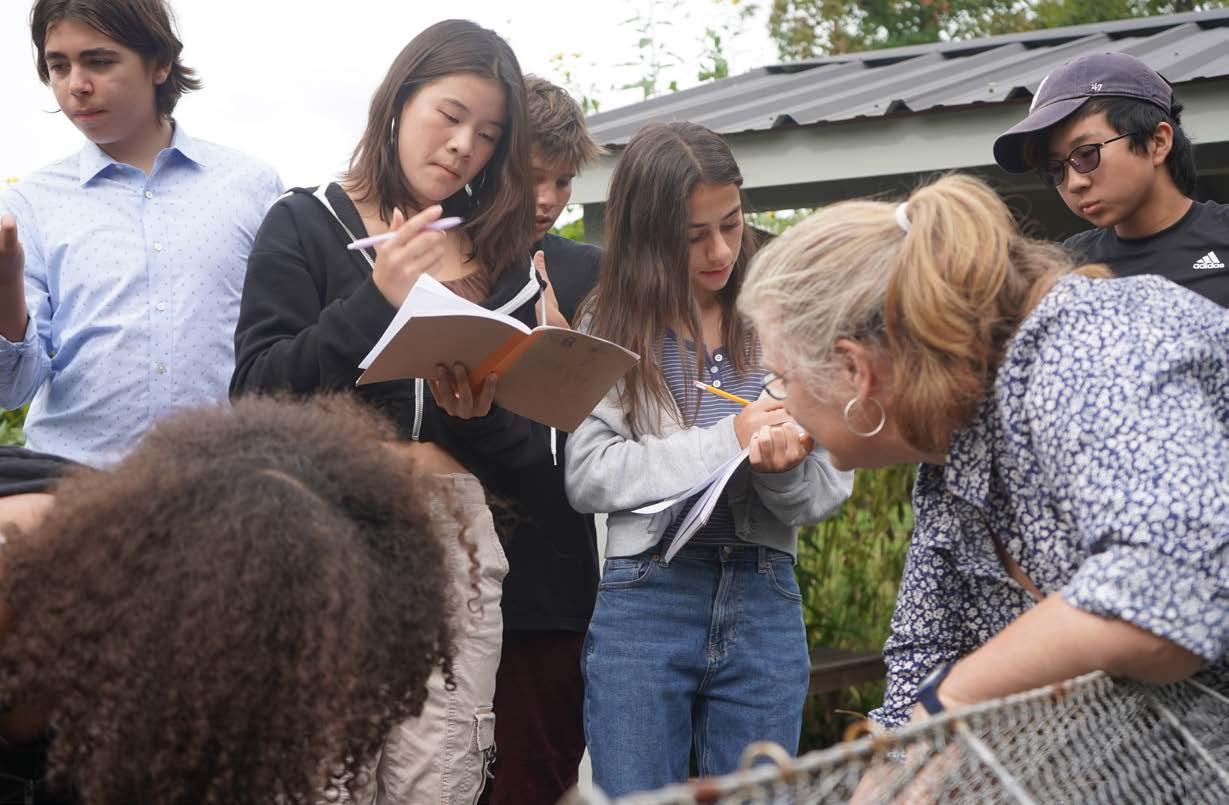
“The garden at D-E is space for place-based learning, ...it’s a place to learn about conservation that’s regionalised. It became the place that kicked off the environmental club in the Middle School and a place where students take initiative and leave legacy projects.” - Tasha Urbanowski
With the current Netti-Louise Coyt D ‘37 Garden, Middle School students at the time initially imagined a a high production crop garden. However, when it came to surveying faculty about how they’d use the garden, they adjusted their expectations to the needs of the community; a teaching garden would suffice.
23
And a teaching garden it became! With each annual fall harvest come plenty of opportunities for hands-on learning and exploration. Hannah Caroll ’25 , one of the three Upper School Garden Club Presidents noted how, “in my ninth grade history class we compared the agricultural revolution to hunter-gatherer societies. We tasted how different food was before the potato and other crops. They tasted really good!”
The garden hosts a wide range of plants and crops, including sunchokes, potatoes, purple amaranth, and cultivated wheat––all of which are important to studying Early World History in ninth grade. Feeling the small bits of amaranth grain between your fingers and comparing that to huge stalks of wheat in the adjacent garden bed puts history into perspective. Mx. Ambler, ninth grade history teacher, explains how, “there is not a lot of historical record from that period, not a lot of artifacts. I think one of the wonderful things about D-E is that they’re willing to devote resources to have something like a teaching garden. Tasha will partner with you to propose specific things to grow to be ready for you when you want to use them. It’s wonderful to have something that is visual, tactile, and experiential. It’s like a couture lesson.”
Lessons like these are the fruits of consistent time and effort. Over the years, students’ efforts have inevitably looked different. For the beloved chicken coop to be installed in the current garden, students learned that it was illegal to house chickens in the city of Englewood. In the span of three years, students researched local law, found the ordinance, presented their proposals to the Englewood Board of Health, and then applied for the first license to have chickens in the city–––a feat beyond what was initially imaginable! Now, D-E’s flock of chickens are the in-house pest managers and soil turners.
More than a dream, gardening at D-E is a material practice: a collective ritual that serves to inspire students and realize a deeper relationship to the world around them.
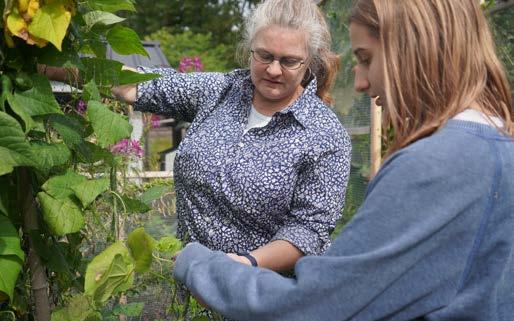
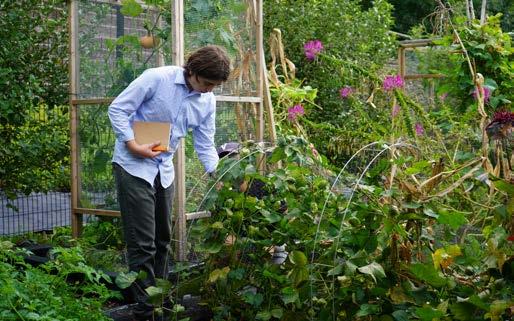

If anything, D-E’s garden is about building relationships with our climate, plants, animals, and each other. A new sense of ecological literacy and curiosity germinates. Leonard Glozman ’25, co-President of the Garden Club appreciates that, “what the garden has done for me is expose me to this world of organic farming. We’re not a farm, yet we all grow all these things and with a surplus to donate. It teaches you about diversity too. In the
supermarket, you’ll just find russet potatoes, but being here, we have so many colors and varieties. And it’s a better practice for food security. Hopefully, it brings awareness to diversity in food and encourages people to eat in variety.”
Scan the QR Code or visit d-e.org/apiary to learn about D-E’s Happy Bees Honey, including harvesting, details about the D-E Beekeeper, and more!
CS A N M E FORADDITIONAL CONTENTONDETOD A Y O GR 24
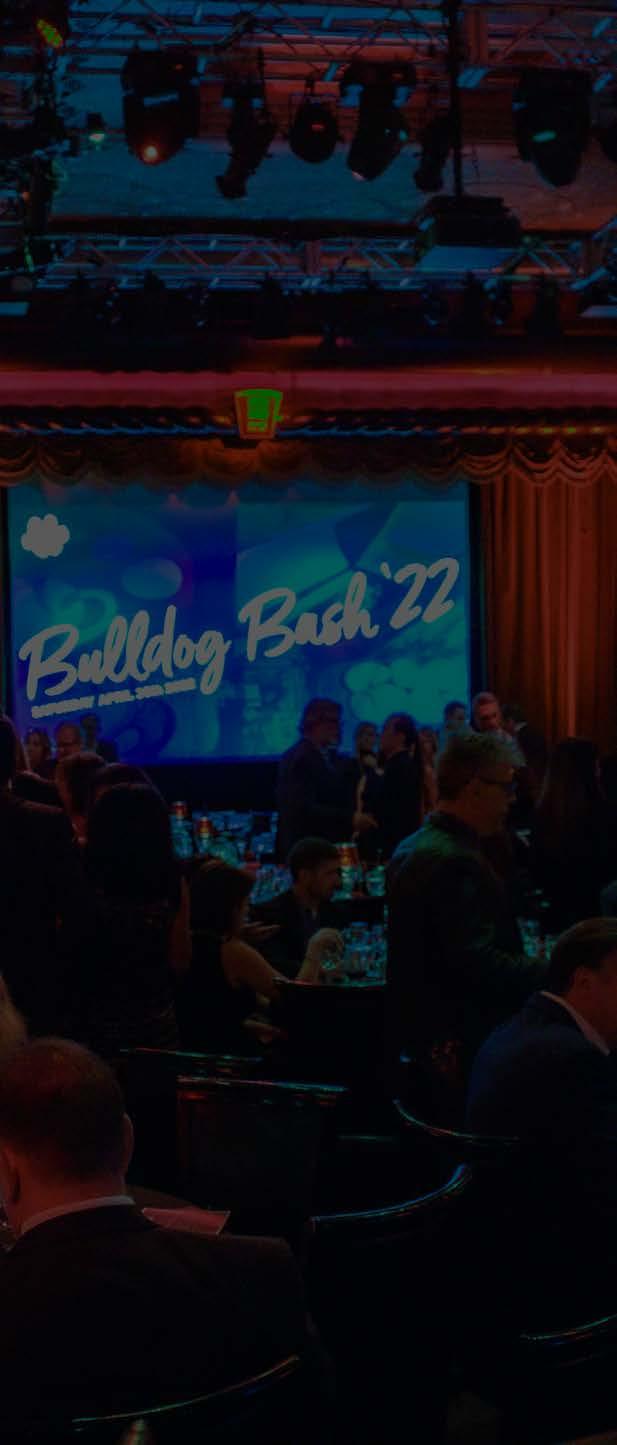
Save-The-Date The Installation of Dwight-Englewood Head of School Jeremy Gregersen
at
PM Leggett Field A reception will follow the ceremony Bulldog Bash 2023 SAVE-THE-DATE: SATURDAY, APRIL 29, 2023 Plan to join us for the D-E event of the year!
to BE
Event details
invitation
Sunday, May 7, 2023
2:00
The Bulldog Bash is THE place
on April 29, 2023!
and
coming soon! For a look back at Bulldog Bash 2022, visit d-e.org/events or scan the QR Code. Questions and/or want to get involved? Email Linda Binder, Director of Special Events, at bindel@d-e.org
Dwight-Englewood School
315 East Palisade Avenue Englewood, NJ 07631
This year’s Fall Play was Shakespeare’s beloved comedy, “A Midsummer’s Night’s Dream,” performed and staged beautifully by both Middle and Upper School students! Hajjar Auditorium was transformed into a vivid, dreamy fairyland. See inside for more co-curricular seasonal highlights from the 2022-2023 year thus far!





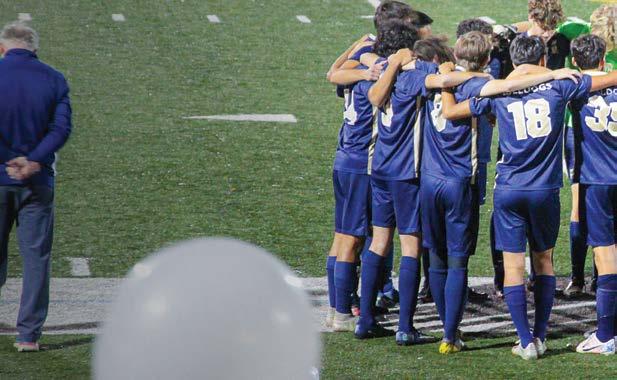

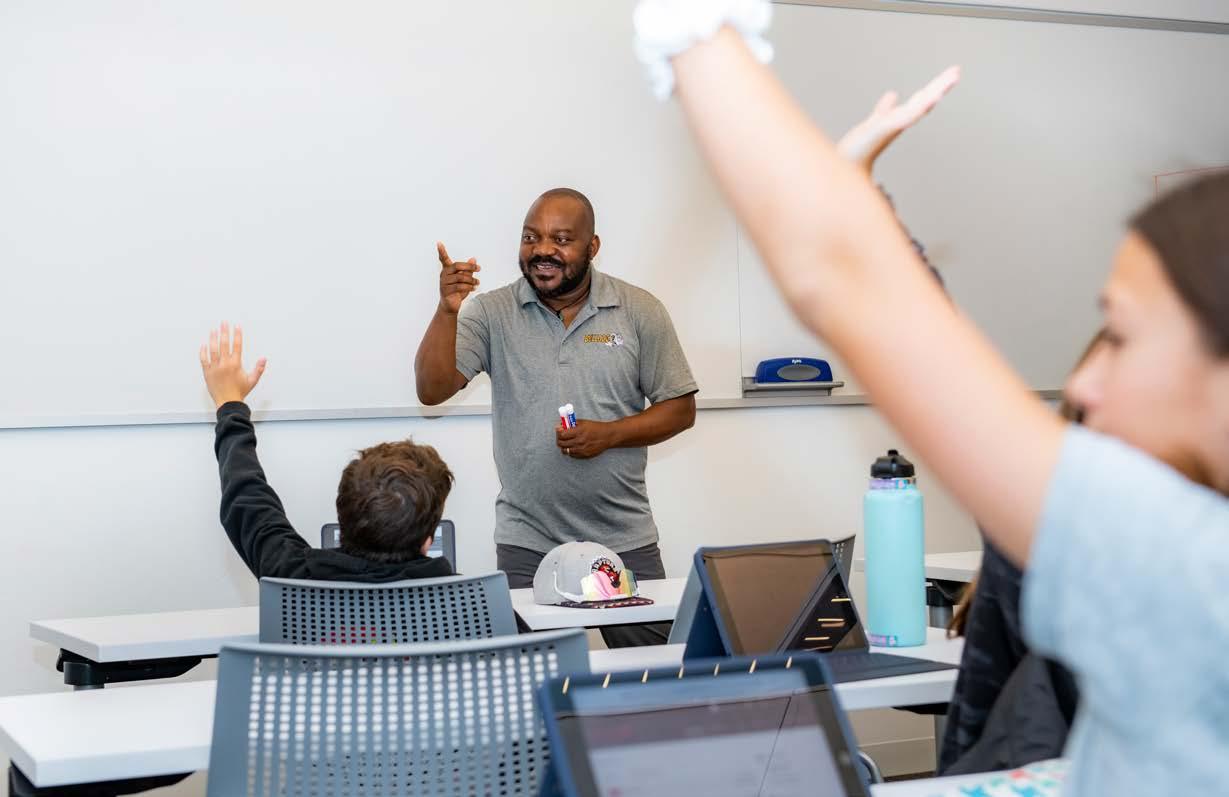








 Jeremy Gregersen was presented with a symbolic, custom-inscribed “key” to Dwight-Englewood School by Rob Miller.
Jeremy Gregersen was presented with a symbolic, custom-inscribed “key” to Dwight-Englewood School by Rob Miller.








































